Fiestas y tradiciones
El acervo cultural de Larraga se manifiesta en nuestras fiestas y en nuestras tradiciones, que, heredadas de nuestros mayores, perviven en la actualidad
Calendario festivo
Tres fechas sobresalen en el calendario festivo de Larraga, que son:
El día 3 de Mayo, festividad del Santo Cristo del Socorro, el 6 de agosto, con las fiestas patronales y el 29 de Septiembre, celebración del Patrono de la Villa San Miguel Arcángel. En los tres casos hay que destacar las procesiones que se llevan a cabo.
Además, las fiestas en honor a San Miguel Arcángel, celebradas en los últimos años del 5 al 11 de Agosto, cuentan con el atractivo, como ocurre en la mayor parte de los pueblos de La Ribera, de los encierros y de las capeas de vacas, máxime teniendo en cuenta la existencia de tres ganaderías de reses bravas en el pueblo.
En el apartado costumbrista podríamos mencionar a las hogueras de San Antón, las cuales se celebran la noche del 16 de Enero, víspera de su festividad. En ellas, se encienden las hogueras y se ruega a San Antón que proteja a los animales de la casa. La fiesta acaba compartiendo la cena ante las brasas de la hoguera. El 3 de Febrero, festividad de San Blas, es costumbre acudir a la Iglesia con los collares de roscos que se hacen en casa para implorar al Santo protección contra los males de garganta. Y por último, podríamos mencionar las Javieradas, a comienzos de Marzo, en las que tras la peregrinación de Larraga a Sangüesa, los ragueses abren el Vía crucis hasta Javier con una gran cruz de madera de la Cofradía de la Vera Cruz.





